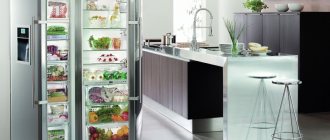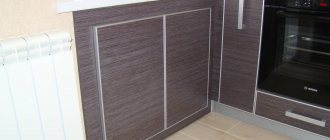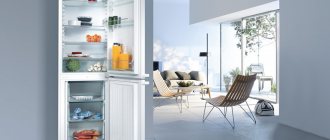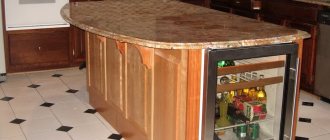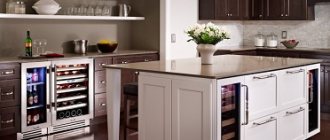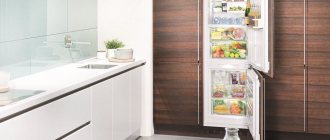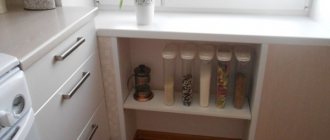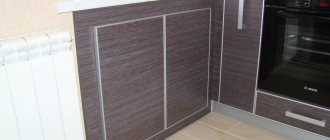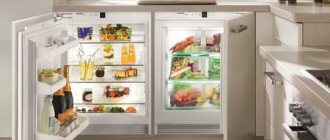/Appliances/
Is it possible to place a refrigerator next to the stove? And next to the oven or radiator? What happens if you put a microwave on top? We answer right away: all these combinations are undesirable, but in hopeless situations they are quite possible. The main thing is to protect the refrigerator from heat.
- The fact is that the heat from the stove forces the compressor to work in intensive mode, as a result, energy consumption increases, the device wears out faster and fails earlier. Refrigerator models in which the refrigerant circuits run along the sides especially suffer from heat.
How to reduce the harm of proximity to a stove or other heat sources to a minimum? This is exactly what we will talk about next. To quickly find the answer to your question, click on the appropriate link from the list. Or continue reading in order.
- Stove next to refrigerator
- Refrigerator next to oven
- Refrigerator next to the radiator
- Refrigerator next to another refrigerator
- Microwave on the refrigerator
Attention! Any failure to comply with the installation conditions for the refrigerator specified in the instructions for a specific model may result in denial of warranty service if the device breaks down.
Why shouldn't you place the refrigerator next to the stove?
There are a lot of arguments against it, ranging from the usual loss of comfort to premature failure of the refrigerator. Moreover, we draw your attention to the fact that there is no difference whether you place the refrigerator next to a gas stove or an electric one. Their sides heat up equally, especially if we are talking about a working oven. But, let's take it in order.
The heat from the stove makes the refrigerator work at its limit.
Some people think that proximity to a hot stove can lead to the fact that the refrigerator compartment will not cool very well, and that’s all. Or rather, temporarily warm up from the heat. That is, it’s worth revving up a little and the problem will be solved.
But it's not that simple. It's just the opposite. The warmer it is around, the more intensely the compressor generates cold... And the optimal temperature in the refrigerator will not drop, no. But this state of affairs is not at all useful for the technology itself.
The refrigerator is designed to automatically turn on the compressor at certain intervals. But when the outside temperature rises, the compressor is simply forced to work hard to maintain the desired temperature.
Naturally, the service life of the equipment in this case is reduced many times over. Especially if you have a large family and the stove runs very often. Heat the same kettle five times a day, cook some soup, heat up some dish...
And, even if you just fried eggs, the side of the stove does not heat up and cool down as quickly as it seems. The heat, accordingly, first reaches the adjacent side of the refrigerator and maintains an elevated temperature for a long time.
And the compressor turns on and on, without breaks for lunch and dinner. And even without smoking breaks.
However, this is all written in the instructions for the refrigerator. But, if you don’t believe it, you can ask any workshop and the specialist’s answer will be unequivocal: you shouldn’t do that.
Although, if you are so rich that you change refrigerators like gloves, then why not? The compressor will “fly” in five years (or even a little earlier) - buy new equipment, and that’s the end of it.
IMPORTANT - check the walls
One of the key components of the refrigerator is the capacitor. Freon circulates in it, which takes heat from inside the refrigerator or freezer and releases it outside. Therefore, it is important that there is free access of air to the condenser grille.
Most refrigerators have a condenser on the back wall. But there are models in which it is located on the side. You can't tell it by eye; the tubes are hidden behind the wall. It is better to see their location in the instructions. But if you notice that the side walls of the refrigerator are heating up, then the condenser coil is located in them.
In this case, you need to leave a gap of at least 50 mm between the walls and the furniture. if this is not done, then:
- The refrigerator will cool food more slowly.
- The compressor will turn on more often and consume more electricity.
- The service life of the refrigerator will be reduced.
- The risk of compressor failure will increase significantly.
Electricity bills
And not only are you simply “killing” the motor of your refrigerator, you are also regularly overpaying for light. The refrigerator already drags a lot without this, but if you force it to work 5-6 times more intensely, you yourself understand how much money it will cost.
After all, in order to cool the chamber, the refrigerator needs electricity to “jerk”. So think about whether it is beneficial to arrange kitchen elements this way. But, if you are rich, this argument will not convince you. Then maybe the next one will seem sane?
Imaginary dangers
Both objects under discussion are in contact with each other not by working surfaces, but by side walls. Therefore, the result of contact largely depends on the degree of thermal insulation of the products.
- Temperature conditions - the refrigerator is provided with high-quality thermal insulation by default, the stove - depending on the type. An induction hob or a modern electric oven does not in any way heat up the surfaces in contact with it, thanks to the insulation material and the operation of the fan, if we are talking about an oven. Built-ins are designed to have no impact on adjacent furniture. Moreover, for a refrigerator that has its own insulation.
- The risk of fire is no greater than when the stove comes into contact with any other piece of furniture.
- Aesthetics - the interior of the kitchen is determined by furniture, utensils and the design of walls and windows. The refrigerator and oven are standardized objects that can be combined without difficulty.
Food spoilage
Such “swings” are not in vain for the internal microclimate of the refrigerator chamber. There is no stability of cooling, you understand, therefore, there is no way to maintain an even temperature.
And as a result, sometimes the food will simply freeze. This is especially bad for fresh vegetables, fruits, and herbs. After a bunch of parsley is covered with a thin crust of ice, the smell will almost disappear and there will be almost no taste left.
Also, red caviar really doesn’t like freezing. It tastes completely different and becomes deformed.
Of course, this will not happen right away, but after a couple of years of operation of the equipment in a similar mode. And further! The freezer will also become covered with ice. And you will have to clean it much more often than under normal conditions.
Splash protection
A distance of 25 cm does not solve the problem of splashes during cooking. It is assumed either to clean the wall immediately after cooking, or to use improvised means. The simplest solution is a foil screen in a metal frame, which is secured with magnets or hooks. It is not recommended to use PVC film and its analogues: the material does not tolerate high temperatures, and splashes during cooking can be very hot.
Difficulty in dealing with greasy drops on the walls of the refrigerator
Another minus. At first it seems: what’s wrong with that? I’ll cook it and immediately wipe off the splashes. But, as always happens, you immediately become too lazy to wipe it off, the drops dry up tightly, and then look ugly against the backdrop of the snow-white side of the refrigerator...
But getting rid of them is now not so easy, because the delicate enamel of the refrigerator is not like a ceramic “apron” on the wall, and it will not withstand friction with an iron brush.
In general, you will have to keep an eye on this matter all the time and do not forget to wipe it right away. And this is no longer good, it’s annoying.
Of course, if you have absolutely no other way to place the elements, then we will tell you how to protect the refrigerator from grease. But, nevertheless, we insist that you think carefully again.
What to do if there is no other way out
When purchasing a refrigerator, a reasonable person immediately decides on the space that can be allocated for this in the kitchen. A thoughtless purchase often leads to the unit being moved into the living room or hallway. There are models no more than 50 cm wide, they take up less space than standard ones, and there is no need for close proximity. Sometimes, in order to purchase a coveted device, owners buy a mini-stove or a small sink, which also causes some inconvenience.
Unit from the stove
In a limited space, it is necessary to clearly calculate the options for the location of the most necessary things, and take into account natural factors - natural air circulation, sunlight and possible heating. The need to constantly wash the wall located near the stove is not the only trouble. There is also inconvenience in using frying pans with handles, large pots, as well as harm from exposure to moisture due to boiling liquids, of which water is the most harmless.
Additionally
People have come up with many ways to avoid damaging heat - placing an insulating sheet or partition between two kitchen attributes, or lining the unit itself from an insulating material.
For this, wood, tape, drywall, and polymer materials are used.
Large distance to the stove
But as soon as it gets warmer outside, you have to take the next step - installing a hood above the refrigerator. Because the heat rises and warms its lid. The price of such a device is much higher than what was originally planned for the purchase of the refrigerator itself, especially when you consider the time spent on construction and acquisition. So you should think through all possible options in advance and choose the best one for yourself.
And finally: Feng Shui is against it!
For a snack of all the minuses - here's the opinion of Feng Shui. For some reason, the refrigerator is considered an object that personifies the element of Water. But the stove is Fire. And these two things do not get along with each other, which means they bring a negative aura into the house, thicken the climate of your apartment and fill it with alarming fluctuations...
So, if there is a quarrel in your house, know: it’s all to blame for the refrigerator, which you, without thinking, placed next to the stove.
How to post
The minimum safe distance between a refrigerator and a gas stove is 20 cm. Some manufacturers of household appliances recommend a distance of 30 cm.
For electric stoves, this distance is significantly reduced - to 3-5 cm.
If you have an induction hob with an electric oven, they will not pose any risk to your refrigerator and you can arrange these appliances as you wish.
We place the refrigerator
What to do if it is impossible to prevent the close proximity of a refrigerator and a gas or electric stove, how to protect household appliances?
What are the alternatives for placing a refrigerator?
If you are deeply moved by our beliefs, then you need to abandon this idea and look for another place for the refrigerator.
Unfortunately, we don’t know your layout, but for some reason we assume that your kitchenette is very small, which means, most likely, you are the owner of a Khrushchev-era apartment.
So, if this is the case, then it really is bad. There are no adjacent storage rooms in a niche in which you can put a refrigerator, nor a balcony that can be combined with the kitchen and take equipment there.
But on the other hand, there is a wonderful advantage in Khrushchev apartments - the interior partitions there are not concrete or load-bearing. Therefore, if your refrigerator does not fit on the opposite wall, then you can simply make a small opening in the wall between the kitchen and living room and build a niche from it.
This way, the kitchen will remain uncluttered, the refrigerator door will be flush with the wall, but a washing machine can be installed in its place. This, after all, is also the problem of Khrushchev apartments, with their two-meter bathtubs.
And the fact that in the living room the wall will not be flat, but with a difference, is even interesting. You can decorate the ledge in any way you like, hang pictures or shelves on it.
Also: when looking for another place for the refrigerator, do not forget that it is not recommended to place it not only next to the stove, but also to the radiator. It will be the same, or even worse. Heating in this case is seasonal, but continuous for many months.
The same goes for the gas pipe. It gets warm, which means it is a bad neighbor for the refrigerator and it has no place near it.
Correct calculations
The upper and lower cabinets of the kitchen set are an indispensable component of any kitchen, including a huge studio kitchen with a dining area, common in luxury new buildings, and small and cramped in a standard Khrushchev-era apartment. Before looking at tempting photos of kitchen furniture in glamorous magazines and planning a purchase, you need to weigh all the components of your choice.
They include not only modern design, finishing materials and the number of items. They also take into account the height of the main user, the height of the ceilings in the room, and the footage on which all this will have to be installed.
There are a lot of publications on the topic of ergonomic equipment for a small space in the kitchen.
These standards are the result of scientific research, experiments and measurements. Moreover, each distance is provided for a specific purpose and carries its own meaning.
The main standards are aimed at creating optimal conditions for those working in the kitchen:
- It is recommended to place a wall cabinet in the kitchen at a height of 1.9 meters from the floor, regardless of the height of the ceiling. This allows the housewife to reach the desired object above without resorting to auxiliary devices - a low stepladder, stool, or small bench. You can deviate from this rule only when the height of the main user is much higher than average. This height makes it easy to inspect all the contents and get the necessary items without much effort.
- The floor part of the kitchen wall should be located at a distance of at least 0.6 m from the bottom of the wall part. Compliance with this condition will allow you not to perceive the upper cabinet in the kitchen as an obstacle to work or to place household appliances in the created space for working in the kitchen.
- The standard distance for the bottom of a kitchen cabinet from the floor is 1.5 meters. Simple calculations show that with a height of 90 cm for the lower part of the set, it is easy to maintain both the space above the tabletop and the required distance from the floor. However, recent statistical studies have shown that the majority of users not only do not follow the rules of how everything should be placed for working in the kitchen, but also do not know about their existence.
These are standard parameters that are usually used to create the convenience of adult family members. But with individual planning, it is quite possible to make deviations from them.
The small stature of the housewife or the tall stature of the owner, who spends a lot of time in the kitchen, means that the numbers vary for the most rational placement.
The distance between cabinets in the kitchen is a prerequisite for productive work. Placing them close together deprives the owner of significant functional space between the table top and the hanging part.
An incorrectly chosen distance between cabinets can lead to permanent injuries or the development of spinal diseases due to the need to take an uncomfortable position when working.
Accurate calculations for non-standard growth rates will allow you to properly organize the workspace in the kitchen, then you will have to get tired much less. Therefore, all distances must be verified.
How to minimize the risk of proximity between a stove and a refrigerator?
If you have reached this block, then you are definitely not impressed by our “horror stories” and our rationale for moving the refrigerator did not find a response in your soul.
Well, if you really want to put these two things next to each other, then you definitely need to separate them somehow, at least with some small partition. Of course, the thicker the insulation, the better, but rather than nothing at all, a thin piece of some material is still better.
We will give you examples of the most popular options, and you can choose which one you like best.
Before we start looking at thermal insulation using examples, I would like to note this:
There is no point in attaching a shield that will be located between the stove and the refrigerator.
Or rather, fix it “tightly”, for example, with strong glue, such as “liquid nails”, since, who knows, you might someday have a rearrangement and this piece of slab will interfere?
It is best to buy double-sided tape, it holds very firmly and use it to glue the shield to the surface of the refrigerator. Yes, exactly the refrigerator, because the heating side of the stove will simply melt this glue and nothing will stick.
So let's look at protection options.
How to make thermal insulation?
Despite many prohibitions and contraindications, the refrigerator can still be beautifully integrated into the overall interior of the kitchen without harming its operation. Today, there are many modern technologies that will minimize the harm of the “neighborhood” of this device in the kitchen with other heating equipment. To safely isolate devices from each other, it is enough to separate them securely. To do this, you can lay thermal insulation. This is good protection that allows you to isolate the refrigerator from other equipment, as well as close its walls from all kinds of contaminants.
Despite the huge choice of technologies, there is no universal material for thermal insulation. Attaching protective sheets requires not only time, but also money, and replacing thermal insulation is labor-intensive. This is the main disadvantage of its installation. Materials for thermal protection are divided into inorganic and organic:
Organic materials include cork sheets, textolite, reeds, chipboard and polystyrene foam
The main advantage of such insulation is non-toxicity, which is very important for high temperatures. In addition, this raw material is resistant to moisture
The disadvantage of using organic insulation is deformation during the heating process and high cost.
Inorganic materials include mineral fiber, drywall and fiberglass. Such raw materials are affordable, withstand temperature changes well, but are not resistant to moisture. When installing inorganic insulation, it is recommended to use double-sided tape as fastening. It holds the sheets securely and is easy to remove.
Thermal insulation is sold in the form of edged sheets 75 centimeters wide and about 5 millimeters thick, as well as in rolls. The outer side of the material is covered with a special lavsan film, and the inner side is self-adhesive. Before starting pasting, it is recommended to lay the sheets on the floor so that they straighten. Then you can get to work. The sticker is applied to the refrigerator wall along the entire height from top to bottom. It is necessary to leave a distance of about 2 centimeters at the back of the device, this is necessary for air circulation of the condenser. The gluing process itself takes a few minutes.
17photos
Protective screen made of simple chipboard
You can simply buy a piece of laminated chipboard and place it between the stove and the refrigerator. Just do not forget that the side cut will need to be treated with adhesive tape, and this must be ordered at the place where the sheets are cut.
Be sure to choose a sheet to match the kitchen furniture. It would be ideal if it were exactly the same as the main body of the kitchen.
Of course, this shield will not last forever, because chipboard is afraid of hot and moisture, which means that in a few years it may lose its appearance. But such a thing is very inexpensive and we think you won’t go broke if you have to buy another sheet in a couple of years.
Useful tips
It is strictly forbidden to install a refrigerator near heating appliances.
A few recommendations to help extend the life of the unit:
- It is undesirable to install in places where direct sunlight will constantly fall;
- the optimal temperature regime for operation of the refrigeration device is from 14 to 35°C;
- cannot be installed near heating devices;
- When installing a protective sheet on the back of the refrigerator, you need to leave a distance (at least 2 cm) so that air is supplied properly.
There should be a space of at least 5 cm between the refrigerator and the wall.
It is necessary to leave free space from the device to the wall. It should be at least 5 cm. Dust should also be removed from the back wall periodically.
Correct installation and operation are the key to long-term operation of the refrigerator.
The refrigerator is a faithful friend and assistant to any housewife. For full operation, it is important to properly care for the unit and follow all safety precautions. By adhering to the parameters of the distance between the stove and the refrigeration equipment, not only the appearance, but also its functionality will be preserved.
Protective screen with foil, mirror and glass
And this is an absolutely wonderful option. Foil or mirror perfectly reflects heat, and such a partition can be much thinner than other options. The only negative is that the mirror reflection is out of place; it can be removed using corrugated glass placed on top.
This is the most expensive method, but it is also the most effective. The refrigerator will hardly feel any heat from the stove, which means it will serve you faithfully for much longer. In any case, heat reflection is better than simple thermal insulation.
But if you combine these two methods, it will be completely good. That is, put a thick shield and stick foil on top of it.
In conclusion, I would like to say: now you know everything and even more on the topic. But the decision is yours, we just advise and hope that our considerations benefit you.
Norms for determining distances
Modern kitchen design styles demonstrate convenient options when the housewife only needs to reach out from the stove to open the refrigerator door. To achieve this convenience, there are some models in the photographs in advertising brochures that, at first glance, are placed close to the stove.
Layout with stove in the kitchen
But no matter how high-quality the refrigerator’s thermal insulation is, there is a minimum distance that must be left to any heat source - batteries, household appliances, sunlight.
Built-in household appliances
At the service of consumers, almost all models of ovens and refrigerators are produced in two versions:
- built-in;
- freestanding.
In addition to visual appeal and ease of maintenance, the built-in oven has enhanced heat-protective characteristics. Modern models of ovens are equipped with a reliable heat-insulating layer. This can be a layer of insulation or heat-resistant cardboard, which depends on the manufacturer. In the latest models, the doors have triple glazing, which prevents heat exchange between the oven and the outside environment. Safe operation is ensured by a protective shutdown and a fan.
The built-in refrigerator also has additional thermal insulation due to decorative finishing panels.
Additional thermal insulation of built-in household appliances ensures their arbitrary arrangement without taking into account restrictions. Judging by the reviews, the built-in appliances have good thermal insulation characteristics, which makes them reliable and safe. It is perfectly acceptable to place a built-in oven next to the refrigerator, as shown in the photo.
